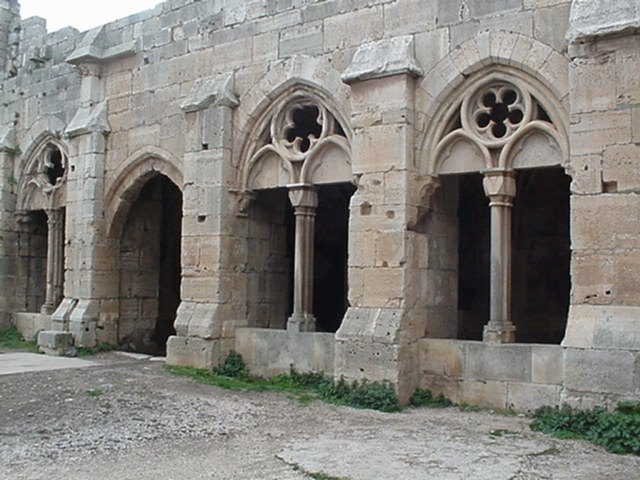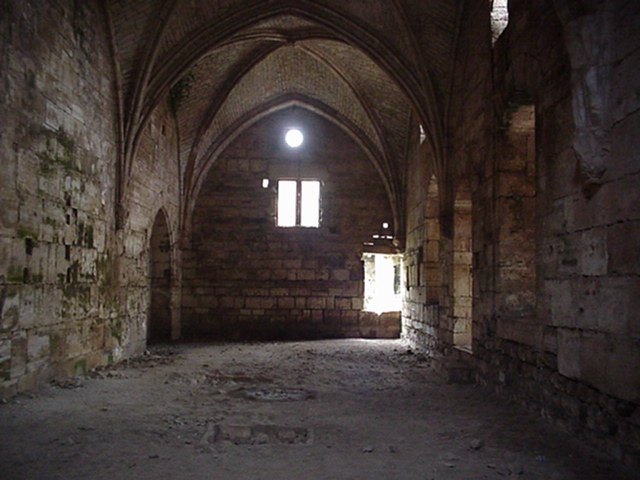

 Krak
des Chevaliers (also known in Arabic as Hisn al-Akrad) is a castle in
Syria originally built for the Emir of Aleppo in 1031 CE but acquired
and extensively rebuilt by the Knights Hospitaller in 1144 CE.
Considered virtually impregnable, it was the largest Crusader castle in
the Middle East and a bulwark against the expansion of the Muslim
states during the 12th and 13th centuries C.E. It was once the home of
Richard the Lionhearted and the castle is today listed as a UNESCO
World Heritage site. The photo to the left, shot from the top of the
castle, shows how it commands the high ground of the area.
Krak
des Chevaliers (also known in Arabic as Hisn al-Akrad) is a castle in
Syria originally built for the Emir of Aleppo in 1031 CE but acquired
and extensively rebuilt by the Knights Hospitaller in 1144 CE.
Considered virtually impregnable, it was the largest Crusader castle in
the Middle East and a bulwark against the expansion of the Muslim
states during the 12th and 13th centuries C.E. It was once the home of
Richard the Lionhearted and the castle is today listed as a UNESCO
World Heritage site. The photo to the left, shot from the top of the
castle, shows how it commands the high ground of the area.
 This
is the interior of the castle, leading to the living quarters.
Above the entry arch is the crest of Richard the Lionhearted (a bit
more
visible if you enlarge the image). The Castle has a series of of inner
and outer walls that made it difficult to breach the gates, should you
survive the assault as you made your way up the mountain
This
is the interior of the castle, leading to the living quarters.
Above the entry arch is the crest of Richard the Lionhearted (a bit
more
visible if you enlarge the image). The Castle has a series of of inner
and outer walls that made it difficult to breach the gates, should you
survive the assault as you made your way up the mountain
 Inside
the central courtyard is the entrance to the main meeting hall for the
king and the knights. Here they gathered for war councils and banquets.
Behind the central meeting hall are the cavernous kitchens and dining
halls
for the foot soldiers. Below this complex are found the stables and
storage
areas. It is an amazingly self-contained structure, located high on a
mountain
overlooking central trade routes. It proved capable of withstanding a 5-year seige.
Inside
the central courtyard is the entrance to the main meeting hall for the
king and the knights. Here they gathered for war councils and banquets.
Behind the central meeting hall are the cavernous kitchens and dining
halls
for the foot soldiers. Below this complex are found the stables and
storage
areas. It is an amazingly self-contained structure, located high on a
mountain
overlooking central trade routes. It proved capable of withstanding a 5-year seige.
 Here
is an interior shot of the royal meeting hall with its vaulted ceilings
and open space. As you can see, even on sunlit days very little light
filters
through the sparse skylights. As a result, the Crusaders relied a great
deal on candles and torches. I thinks this is partly a function
of
the thick-walled construction techniques, and partly a design choice to
ensure protection from any group who breached the walls.
Here
is an interior shot of the royal meeting hall with its vaulted ceilings
and open space. As you can see, even on sunlit days very little light
filters
through the sparse skylights. As a result, the Crusaders relied a great
deal on candles and torches. I thinks this is partly a function
of
the thick-walled construction techniques, and partly a design choice to
ensure protection from any group who breached the walls.
 One
level above the meeting hall were the King's Quarters, a large area
atop
the castle that afforded a view that stretched from the edge of Lebanon
to the east, and northward nearly as far as Hama, our next destination.
Here I am, the knight errant, rescuing a damsel in distress--in this
case
buying a cup of tea to fend off the chilly October weather in the
mountains.
One
level above the meeting hall were the King's Quarters, a large area
atop
the castle that afforded a view that stretched from the edge of Lebanon
to the east, and northward nearly as far as Hama, our next destination.
Here I am, the knight errant, rescuing a damsel in distress--in this
case
buying a cup of tea to fend off the chilly October weather in the
mountains.
 From
Krak des Chevaliers we descended the mountain and drove to the town of
Hama, a forty five minute journey. There we spent the night at the Cham
Palace before traveling the 100+ kilometers to Aleppo the next day.
Hama
is famous for their ancient water wheels, two of which are shown here.
Their construction
dates from the earliest civilizations of the region.
From
Krak des Chevaliers we descended the mountain and drove to the town of
Hama, a forty five minute journey. There we spent the night at the Cham
Palace before traveling the 100+ kilometers to Aleppo the next day.
Hama
is famous for their ancient water wheels, two of which are shown here.
Their construction
dates from the earliest civilizations of the region.
It is difficult to get a sense of the sites above from static pictures and, unfortunately, there are not enough panoramas on Google Maps to make a coherent virtual tour of the castle. In lieu of this, we are embedding a video of a Syrian war correspondent, Oleg Blokhin, which provides a somewhat more coherent pathway through the castle. At the very least, it provides more detail on the castle and places the castle in the context of the current civil war in Syria. I doubt we will ever get to see the Krak des Chevaliers in the state that we witnessed it in 1999.
Click here to go
directly to the
Aleppo page